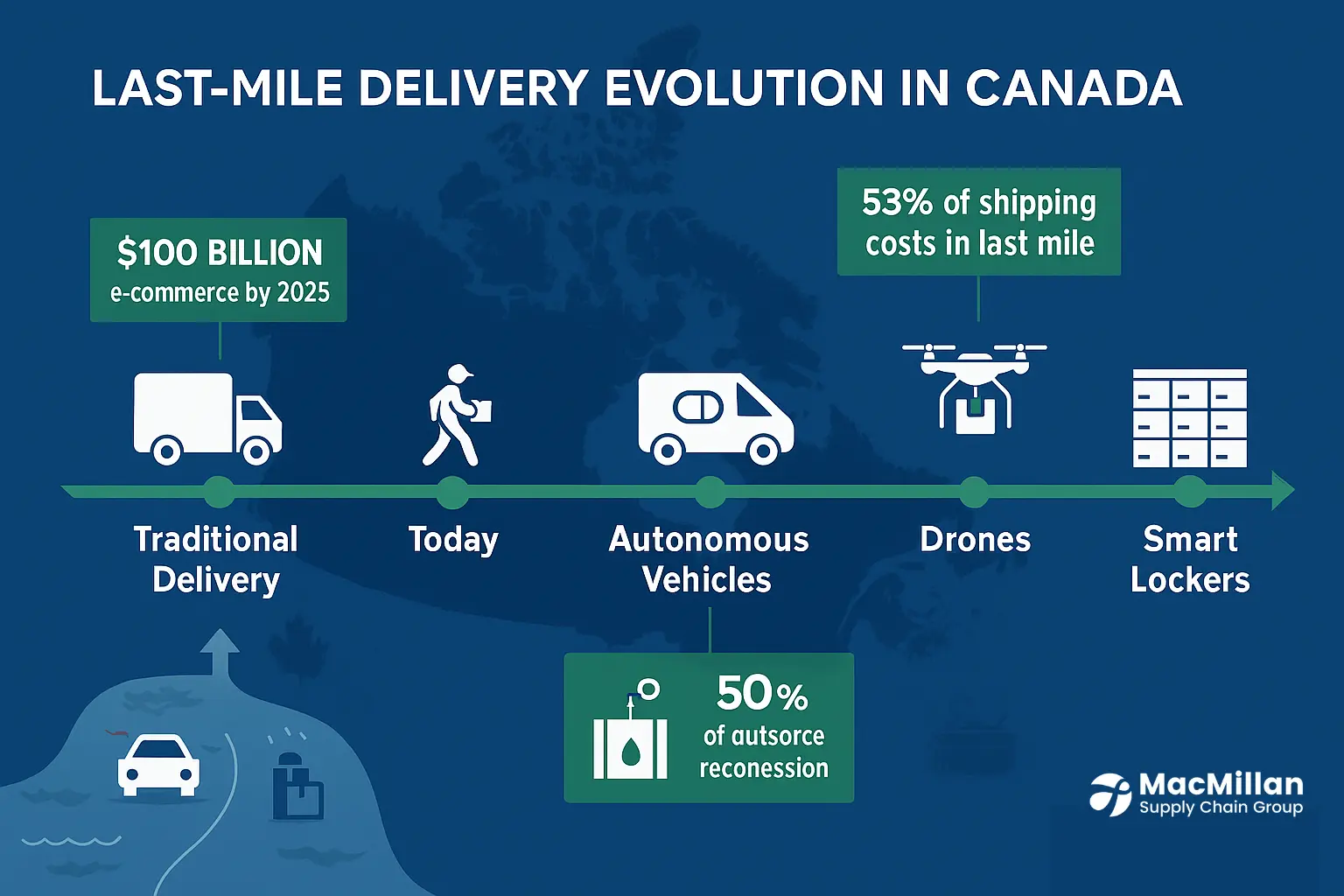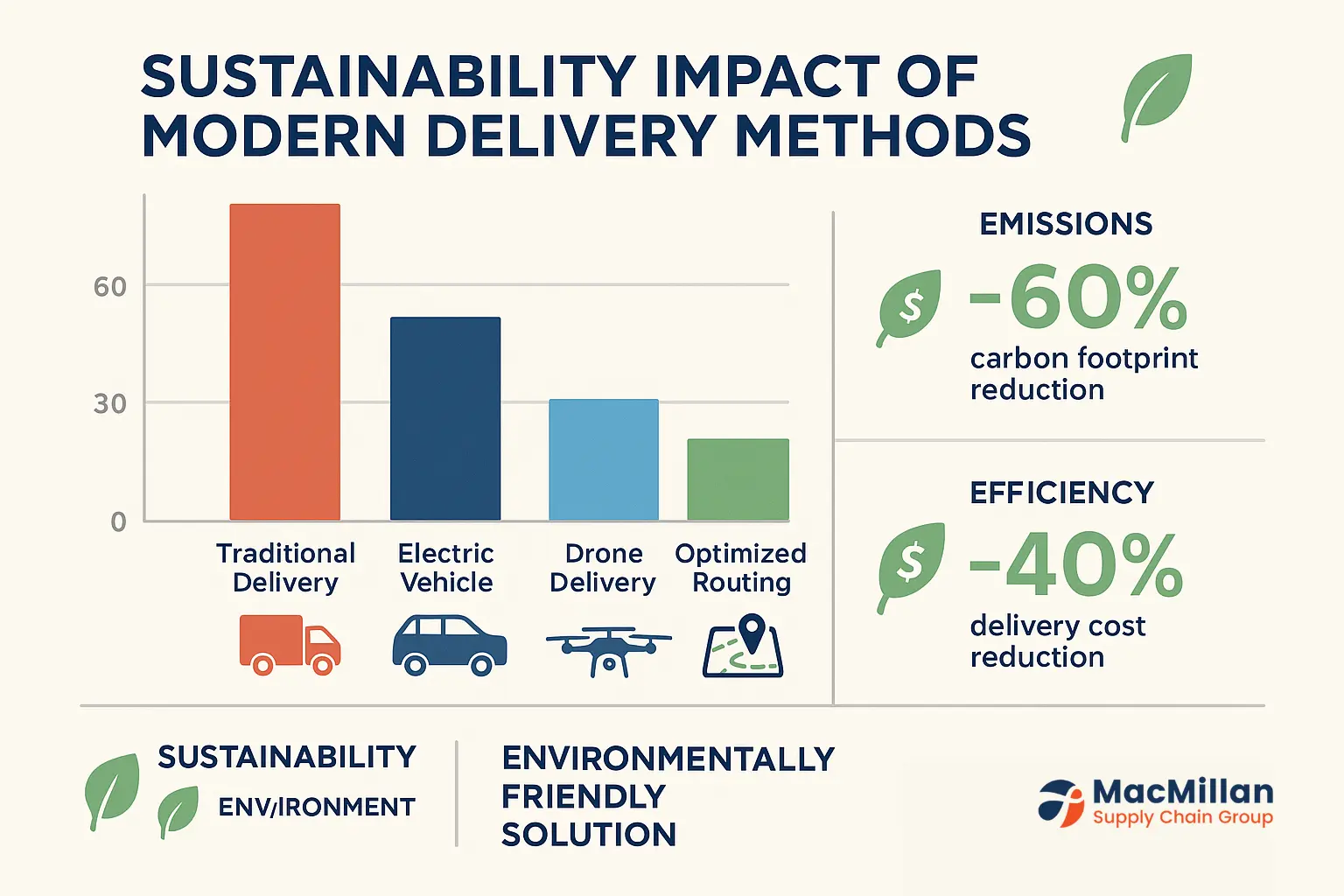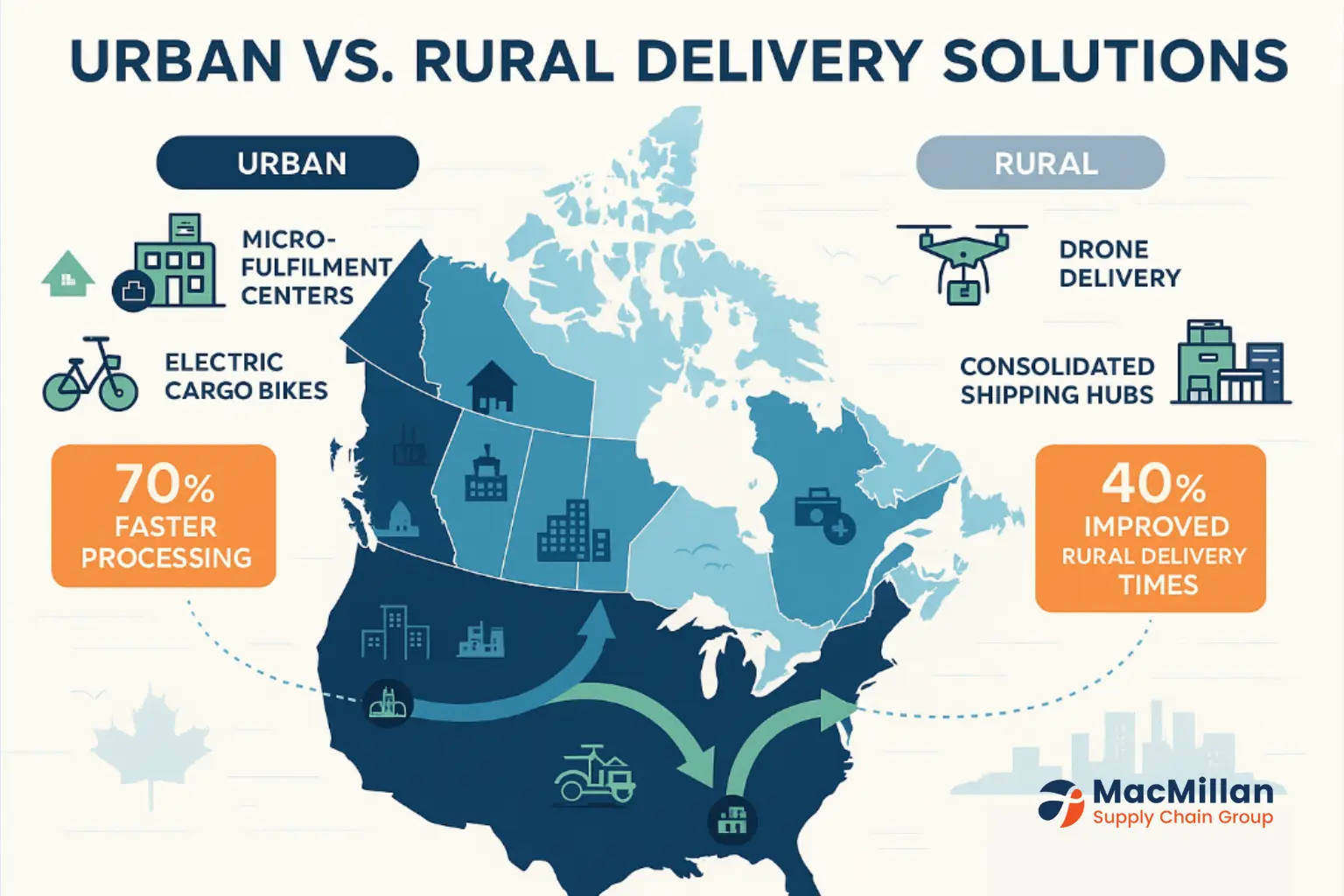The Evolution of Last-Mile Delivery in Canada
The e-commerce industry in Canada is expanding at an unprecedented rate, which presents last-mile delivery with both opportunities and challenges. Customers of today demand delivery options that are quicker, more dependable, and eco-friendly. The logistics sector is adopting technological advancements in last-mile delivery, including drones, driverless cars, and AI-powered warehousing, to satisfy these demands. Leading the way in these developments is MacMillan Supply Chain Group, which uses innovative technology and sustainable solutions to get past issues like cross-border bottlenecks, labor shortages, and delivery challenges in rural areas. This article examines how these developments are changing last-mile delivery in Canada and satisfying the changing demands of online shoppers.
 The Last-Mile Revolution: Advancements in Last-Mile Delivery to Meet Canada’s Growing E-Commerce Needs
The Last-Mile Revolution: Advancements in Last-Mile Delivery to Meet Canada’s Growing E-Commerce Needs
The hardest and most expensive portion of the supply chain has always been the last leg of delivery, from the distribution center to the customer’s door. Last-mile delivery is under more strain than ever before, as it is anticipated that Canada’s e-commerce sales will surpass $100 billion by 2025. In addition to making more purchases online, customers now demand sustainable options, real-time tracking, and quicker deliveries.
The logistics sector is experiencing a surge in advancements in last-mile delivery as a result of this change. The way goods are delivered to Canadian homes is being rethought, from drones hovering over isolated northern communities to robots sorting packages in warehouses. To assist companies in navigating this shifting environment, we at MacMillan Supply Chain Group are welcoming these advancements in last-mile delivery.
However, what precisely are these innovations? How are they handling the particular geographic difficulties faced by Canada? What implications does this have for companies attempting to meet customer expectations? Let’s examine the advancements in last-mile delivery—the tactics and technologies currently revolutionizing logistics in Canada.
Technological Breakthroughs Reshaping Canadian Deliveries
Autonomous Delivery Vehicles: Advancements in Last-Mile Delivery on Canadian Streets
Do you recall the days when autonomous cars seemed like science fiction? Autonomous delivery trucks are starting to appear on Canadian roads today. Businesses in Toronto experimenting with these advancements in last-mile delivery have reported an 80% reduction in emissions and a 30% decrease in failed deliveries. These intelligent cars deliver packages without the need for human drivers by navigating through cities using sensors and artificial intelligence.
Why are they ideal for Canada’s crowded cities? They can avoid the traffic jams that traditional delivery vans encounter by using designated lanes or sidewalks. Although Canadian winters still present difficulties due to snow-covered sensors and icy pathways, they are also weather-adaptive.
Drone Delivery in Canada: Key Advancements in Last-Mile Delivery to Reach the Unreachable
Delivery to remote areas has always been costly and challenging due to Canada’s large geographic area. Let’s talk about drone delivery. Drones can now deliver packages to places with few or no roads because of new Transport Canada regulations that permit Beyond Visual Line of Sight (BVLOS) operations.
Drones are reducing delivery times to minutes in northern communities where a basic delivery could take days using conventional methods. They are especially useful for perishable goods and medications that must be consumed quickly. Although it is still in its infancy, drone delivery represents one of the most significant advancements in last-mile delivery for inclusive delivery services across our diverse country.
Infrastructure Innovations Supporting Advancements in Last-Mile Delivery
Micro-Fulfillment Centers: Bringing Inventory Closer to Customers
The traditional model of massive warehouses in industrial areas is being complemented by a new approach: micro-fulfillment centers. By placing these smaller facilities in key urban locations, inventory is brought closer to consumers. Deliveries can be made the same day or even the same hour thanks to this proximity, marking one of the key advancements in last-mile delivery to satisfy Canadian e-commerce demands.
Smart Locker Networks: Advancements in Last-Mile Delivery for Missed Drop-Offs
The frustration of missing a delivery is something we’ve all felt. Across Canada, smart locker networks are solving this issue. Secure, Internet of Things-connected locker networks are being extended by companies such as Snaile in transit hubs, retail establishments, and apartment buildings.
Carriers can deliver several packages in a single stop at these lockers, which act as pickup locations around-the-clock. When a package arrives, customers are notified and given an access code, which they can use whenever it’s convenient for them. This system lowers package theft, which is becoming a bigger problem as porch piracy increases in Canadian cities, as well as failed deliveries and delivery expenses. For businesses, smart locker networks offer a cost-effective way to improve customer satisfaction while reducing last-mile expenses.
 Sustainability: Advancements in Last-Mile Delivery Driving the Green Revolution in Canadian Logistics
Sustainability: Advancements in Last-Mile Delivery Driving the Green Revolution in Canadian Logistics
Fleet Electrification: Advancements in Last-Mile Delivery for Cleaner Operations
The rumble of diesel delivery trucks is gradually being replaced by the quiet hum of electric vehicles across Canada. With firms like Purolator aiming for 60% electric vehicles by 2030, major carriers are making significant investments in fleet electrification. In addition to being more environmentally friendly, these electric fleets represent important advancements in last-mile delivery, becoming cost-effective over time due to their lower fuel and maintenance expenses.
Electric cargo bikes are having a big impact in crowded cities. These agile vehicles can transport up to 400 pounds of packages through crowded streets and tight alleyways. In urban areas, they frequently deliver more quickly than traditional cars, have zero emissions, and lessen noise pollution. When compared to van deliveries in urban areas, businesses that use these bikes report delivery cost savings of up to 40%.
Sustainable Packaging and Reverse Logistics
Beyond automobiles, sustainable logistics also applies to the actual packages. Businesses are responding to Canadian consumers’ growing expectations for environmentally friendly packaging by using reusable shipping containers, recyclable materials, and appropriately sized boxes. Even packaging that can be planted to produce wildflowers after use is being used by some creative companies!
The handling of returns is equally important. Returned goods can now be processed more effectively thanks to advanced reverse logistics systems, which lower waste and emissions from transportation. These systems minimize environmental impact while recovering value from returned goods by using artificial intelligence (AI) to decide whether items should be recycled, refurbished, or restocked.
AI and Data: Driving Advancements in Last-Mile Delivery Through Intelligence
AI-Powered Warehousing: Working Smarter, Not Harder
Behind the scenes of successful advancements in last-mile delivery is warehouse automation that’s getting smarter by the day. The processing of orders before they even start their journey to customers is being revolutionized by AI-powered warehousing systems. Nowadays, a wide range of items can be recognized, grabbed, and packed by robotic picking systems, which can increase productivity by up to 300% when used in conjunction with human employees.
Not only do these systems operate more quickly, but they also gain knowledge and get better with time. Order patterns are analyzed by machine learning algorithms to optimize inventory placement, placing frequently purchased items in convenient locations. To guarantee that there is enough inventory on hand when needed, they can even forecast demand spikes based on variables like impending holidays or weather predictions.
Route Optimization and Real-Time Tracking
Delivery routes have changed. Delivery trucks of today travel routes that are dynamically optimized to adapt to weather, traffic, and even new orders placed during the day. AI systems find the most efficient routes by analyzing a variety of factors, which lowers fuel consumption and guarantees on-time delivery.
Real-time tracking is now expected by customers rather than an extravagance. These days, GPS-enabled systems let customers track the progress of their packages on a map and offer precise delivery windows, sometimes down to the minute. Some advanced systems even enable communication between drivers, allowing for last-minute delivery or location instructions. This transparency promotes trust and reduces the anxiety that comes with expecting big deliveries.
Challenges and Advancements in Last-Mile Delivery Across Canada
The Urban-Rural Divide
Rural communities frequently struggle with a lack of delivery options, while urban centers benefit from innovations like electric cargo bikes and micro-fulfillment centers. Traditional delivery is costly due to the great distances between homes, and there is little infrastructure for new technologies like electric vehicle charging stations.
Severe Weather
The winters in Canada present special difficulties for delivery services. Roads can become impassable due to snow and ice, autonomous cars have trouble using covered sensors, and electric vehicles’ battery life is impacted by extremely low temperatures. Planning for the seasons becomes essential to ensuring dependable service all year long.
Cross-Border Bottlenecks
Cross-border logistics add complexity because a large portion of Canadian e-commerce purchases originate in the US. Delivery times can be extended by days and expenses can rise by up to 18% due to delays at important crossings like Windsor-Detroit. International shipments are made more difficult by customs procedures and documentation requirements.
Work Shortages
With courier vacancies up 22% year over year, the delivery industry is facing severe labor shortages. High turnover rates are a result of the physically taxing nature of delivery work as well as rising volume and customer expectations. It’s still difficult to find and keep qualified drivers.
Last-Mile Costs
About 53% of the total cost of shipping is incurred during the last leg of delivery. Smaller companies find it challenging to compete with larger companies that can more readily absorb these costs due to the pressure this disproportionate expense places on margins.
 MacMillan Supply Chain’s Creative Solution for Last-Mile Difficulties
MacMillan Supply Chain’s Creative Solution for Last-Mile Difficulties
In Canada’s changing e-commerce environment, we at MacMillan Supply Chain Group have created all-inclusive solutions to handle the intricate problems of last-mile delivery:
Hybrid Delivery Networks for All Communities
We acknowledge that not all parts of Canada can be served by a single delivery method, which is why embracing advancements in last-mile delivery is crucial. Because of this, we have developed a hybrid strategy that, depending on regional requirements, blends traditional delivery with state-of-the-art technology:
We use carefully positioned micro-fulfillment centers in urban areas to facilitate same-day delivery. Warehouse automation systems installed in these facilities can cut processing times by as much as 70%. While our environmentally friendly vans handle suburban routes, our electric cargo bikes handle crowded downtown areas.
We have partnered with drone delivery operators certified for BVLOS operations to serve rural and remote areas. In a fraction of the time required for ground transportation, these drones can reach remote communities. Consolidated delivery hubs, which combine several rural deliveries for efficiency, are a complement to this.
Weather-Resilient Operations
Canadian weather necessitates Canadian solutions. With features like improved battery insulation for electric vehicles running in below-freezing temperatures, our fleet includes all-weather vehicles built especially for northern climates. When weather conditions worsen, our in-house routing software uses real-time weather data to modify delivery methods and schedules.
Instead of waiting for conditions to improve for home delivery during severe weather events, we activate our contingency network of smart locker locations, enabling customers to pick up packages from the closest accessible point.
Seamless Cross-Border Solutions
Our specialized customs clearance team and pre-clearance procedures have expedited the cross-border delivery process. We cut down on delays by an average of 36 hours by electronically processing documentation prior to shipments arriving at the border. Consistent tracking and seamless handoffs across the border are made possible by our strategic alliances with US carriers.
We provide consolidated shipping options to companies that ship from the US to Canadian customers. In these options, multiple orders are combined, shipped in bulk to our Canadian distribution centers, and then sorted for final delivery. This method lowers cross-border shipping expenses by up to 40% and streamlines individual customs processing.
Technology-Enhanced Workforce Strategy: Supporting Advancements in Last-Mile Delivery
We’re changing the way the work is done, not just vying for limited delivery staff. AI-assisted delivery tools that optimize routes and lessen physical strain are provided to our drivers. We’ve given delivery workers a four-day workweek, which has increased retention rates by 35% while preserving delivery capacity through increased productivity.
Through our Technology Training Academy, where staff members can gain expertise in drone operation, autonomous vehicle monitoring, and other cutting-edge technologies, we’re also investing in the workforce of the future. This increases our ability to use specialized delivery methods and opens up career advancement opportunities.
Cost-Effective Scalability
We provide adaptable last-mile solutions that grow with demand, leveraging recent advancements in last-mile delivery, for companies of all sizes. By using the same delivery infrastructure, our shared delivery network enables several companies to split expenses while preserving brand identity through personalized packaging and delivery experiences.
Our on-demand capacity expansion uses temporary micro-fulfillment spaces and our network of certified delivery partners to manage volume spikes during peak seasons without sacrificing service quality. Even during the busiest shopping seasons, such as Black Friday and the holidays, this flexible approach guarantees dependable delivery.
Partnering with MacMillan Supply Chain for Last-Mile Success
You don’t have to face the difficulties of last-mile delivery alone, even though they may seem insurmountable. You can turn your delivery operations from a problem into a competitive advantage by working with MacMillan Supply Chain Group.
Starting Is Easier Than You Think
Start with a thorough delivery evaluation from our logistics professionals. To find immediate areas for improvement, we’ll examine your present delivery practices, client expectations, and corporate objectives. Whether you’re a small business shipping dozens of packages every week or a large enterprise moving thousands every day, this no-obligation consultation offers practical insights.
You can apply solutions gradually thanks to our modular approach. As your company expands, start with the components that will help you overcome your biggest obstacles, like integrating smart lockers or using sustainable packaging. In order to minimize disruption during implementation, our systems are made to seamlessly integrate with your current e-commerce platforms.
Measurable Benefits from Day One
Companies that work with MacMillan Supply Chain usually experience:
15%–30% reductions in delivery costs
A 25% increase in customer satisfaction
The efficiency of return processing rose by 40%
A 60% reduction in carbon emissions for last-mile operations
These upgrades are made without spending money on new cars or infrastructure. You can access cutting-edge delivery capabilities with our shared infrastructure model without having to pay the related overhead.
Ready to Transform Your Last-Mile Delivery?
To arrange your delivery evaluation and learn how our cutting-edge last-mile solutions can assist you in satisfying Canada’s e-commerce needs, get in touch with MacMillan Supply Chain Group right now.
Contact us or visit our site to take the first step toward delivery excellence. Your customers are waiting—but they won’t wait forever.
Follow us on LinkedIn for real-time tariff updates
FAQS
Technological innovations like micro-fulfillment centers, AI-powered route optimization, and autonomous delivery vehicles have significantly reduced delivery times across Canada. In urban areas, same-day delivery is becoming standard, while rural delivery times have improved by up to 40% through drone delivery and consolidated shipping approaches. The key factor is bringing inventory closer to customers and using technology to optimize the delivery process.
Canada faces a distinctive combination of challenges: vast geographical distances, extreme seasonal weather variations, a population concentrated in urban centers with vast rural areas, and significant cross-border e-commerce activity with the US. These factors create a need for highly adaptable delivery solutions that can function in diverse conditions while remaining cost-effective across low-density regions.
Autonomous delivery vehicles are currently being tested in controlled environments and specific neighborhoods in cities like Toronto and Vancouver. These include sidewalk robots for small package delivery and self-driving vans for larger deliveries. The Ontario AV pilot program provides a regulatory framework for testing while ensuring public safety. Full implementation is expected to expand gradually over the next 3-5 years as technology and regulations mature.
Transport Canada has established comprehensive regulations for commercial drone operations, including specific requirements for Beyond Visual Line of Sight (BVLOS) flights essential for delivery services. Operators must obtain a Special Flight Operations Certificate, maintain specific pilot certifications, and use approved drone models with appropriate safety features. These regulations balance innovation with safety concerns, particularly in populated areas.
Micro-fulfillment centers are much smaller (typically 10,000-15,000 square feet versus 100,000+ for traditional warehouses) and located within urban areas rather than industrial zones. They focus on fast-moving inventory with high automation, enabling same-day delivery capabilities. While traditional warehouses store vast product assortments for weeks or months, micro-fulfillment centers maintain limited, high-demand inventory with rapid turnover, prioritizing speed over storage capacity.
The most effective sustainable logistics practices in Canada include electric vehicle implementation for urban deliveries, route optimization to reduce miles traveled, consolidated shipping to maximize vehicle utilization, and eco-friendly packaging solutions. For many businesses, a hybrid approach works best: electric cargo bikes in dense urban areas, electric vans for suburban routes, and optimized traditional vehicles for rural deliveries where charging infrastructure is limited.


 MacMillan Supply Chain’s Creative Solution for Last-Mile Difficulties
MacMillan Supply Chain’s Creative Solution for Last-Mile Difficulties